Musica de Camara is a thirty-four year old organization with the valuable mission of increasing performance opportunities and audience awareness in minority communities, especially, but not exclusively, among Hispanics and Latinos. An enthusiastic audience turned out for the concert, a respite from the relentless February weather. The founder of Musica de Camara, Eva de la O, was the personification of charm in her pre-concert greeting, in which she shared her dismay at a radio interview when she was a performer (soprano), during which the interviewer said that he didn’t know there were any Puerto Rican classical musicians, or any appreciation of the repertoire.
All the selections were from the standard repertoire, appropriate for a lighter “Valentine’s Day” event, although I would have welcomed some contemporary Latin classical music, to bolster the mission statement. I understand this will occur on their next concert. Again, in keeping with the spirit of the occasion, I can report that all the performances were heartfelt, even when details slid by the board. In a program of such standard repertoire, the pressure on the musicians is much higher, because of inevitable comparison with all who have gone before. Each of the three musicians was very sensitive, but at their young stage of development, they may need further technical refinement to take their rightful place among the very best.
The discovery of the evening for me was the cellist Brian Sanders, who opened the program with two movements from Bach’s Suite for Solo Cello No. 3 in C Major, BWV 1009, played with flawless intonation, and natural phrasing, despite his unusual bow hold. It made me wish to hear the entire suite, which was probably considered too heavy for the occasion. Perhaps the tie-in with “Valentine’s” is that the only extant manuscript copy of the cello suites is in the hand of Bach’s second wife, Maria Magdalena.
Pianist Byron Marc Sean followed with a rendition of Chopin’s Berceuse, Op 57. One critic compared the colors of the piece to the “shifting hues of an eggshell,” and for the performer the piece can be like walking on those same shells, so exposed and delicate is the writing. The tempo and lyricism were appealing, but it lacked the ultimate intimacy, delicacy, and repose to make it a convincing lullaby. Perhaps some of this was due to opening nerves and a strident piano heard on a tile floor with no absorbing textiles.
Soprano Camille Ortiz-Lafont then performed two art songs by Mozart. The wistful Abendempfindung (Evening Mood) was charming, if somewhat forced. An Chloë (To Chloe) was performed too slowly for this impetuous, adolescent “study” for the character of Cherubino. Both were marred by peculiarities in the German diction.
Mr. Sean found a better match in his rendition of Chopin’s Barcarolle, Op 60, where the tempo and big line were nicely managed, even when certain passages were a bit approximate. However, in the magical “kiss in the gondola” moment, marked dolce sfogato (gently expressed) by Chopin, Mr. Sean’s moment was expressed none too gently. After intermission, Mr. Sean found his stride with his best performance: Chopin’s B Flat Minor Nocturne, Op 9, No. 1. Here his lyricism was heard to advantage, and he handled the repetitive middle section with much more color than is often heard.
Ms. Ortiz-Lafont sang two of Schubert’s best-known songs: Die Forelle (The Trout) and Gretchen am Spinnrade (Gretchen at the Spinning Wheel). In both, the tempi were pushed, depriving the music of charm in the first song, and cumulative passion in the second. I don’t imagine that any of today’s young people have ever seen a spinning wheel, let alone operated one, to understand the “tempo” at which it performs its work. Again, the German diction was so peculiar that it undermined Ms. Ortiz-Lafont’s emotional involvement with the music. Her high notes tend to stick out from the rest of her tone, rather than integrate into her pleasing general sound. Then, as if from heaven, she followed with two songs by the Spanish Catalan composer Xavier Montsalvatge from his Cinco Canciones Negras. Singing in her native language released a flood of effortless musicality and charm that I knew she possessed. Mr. Sean rose to the occasion with fine collaborative pianism.
The concert concluded with the return of cellist Sanders and pianist Sean in the Three Fantasy Pieces by Schumann, Op 73. These were performed with beautiful soaring cello tone, perfect intonation and vibrato, and really fine piano colors underneath. Romantic ardor was entirely present and given realization by both performers. The audience was duly thrilled.
Ms. Ortiz-Lafont favored the room with the delicious encore Del Cabello mas sutil by Fernando Obradors.

